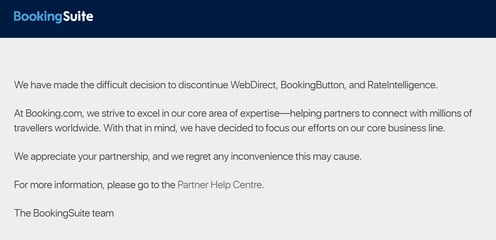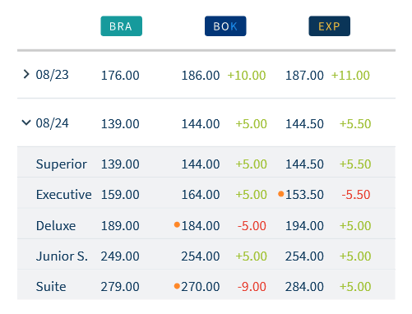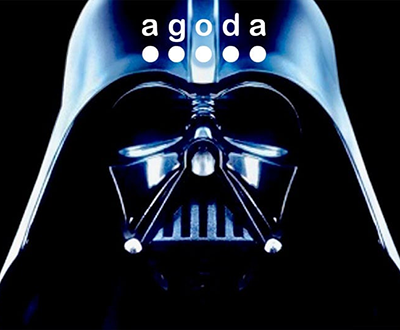Hotels Can Stay Competitive with This Booking RateIntelligence Alternative
Revenue managers and hoteliers have to choose a new rate shopper solution because Booking.com's free rate manager is shut down.
Why should hoteliers consider replacing Booking's RateIntelligence with a paid alternative? In this article, we compare both pricing tools and focus on key differences. These can help independent hotels and B&Bs (Bed and Breakfast) gauge the benefits and make the right choice.
So why did Booking shut down RateIntelligence? Because the OTA (Online Travel Agency) decided to direct its efforts on the "core business line" instead.
Table of contents:
- What was Booking RateIntelligence?
- What is next for hotels and hostels?
- Rate disparity: Turn a limitation into an opportunity
- Software comparison: RateIntelligence vs. Market Intelligence
- Upgrade to stay competitive
What was RateIntelligence and how did it work?
Before it shut down on 30 November 2020, independent hotels used the rate manager to compare competitor rates on Booking.com to their own over the next 365 days.
With this information, they could price inventory on the platform in a competitive manner. The main draw? Access to the data was free.
Hotel managers could cut down on manual rates research and get a basic introduction to analytics-based yield management.
What is next for hotels and hostels?
Starting your research and deciding on new tech can take time and requires trust to make the change. When investing in data and analytics, the tool's benefits and your expectations should be clear.
Consider a rate shopper that delivers easy wins and values your data, but also offers useful features, personal support, and a good user experience.
Despite the discontinuation of Booking's tool, there is a fair amount of discussion on the Partner Community message board. The general consensus? The rate manager was fine for making last-minute pricing changes but less helpful in assisting forward-looking strategies.

Booking greets visitors to its BookingSuite page with a discontinuation notice.
So how to find and decide on a Booking.com RateIntelligence alternative?
Let's take a look:
Rate disparity: Turn a limitation into an opportunity
As the market and demand shift, travelers' booking behavior patterns do too. Their options to find you or your competitors are endless, as is their inclination toward short-term stays at a competitive price.
The Caveat: Limited to Booking
Hoteliers using RateIntelligence could determine only their Booking.com channel rates, which created a problem on two fronts:
- Single-channel distribution
- Single-channel information
This information gap is akin to tunnel vision, a tendency to focus on a single objective.
Such a strategic misstep for independent hotels in competitive locations could leave money on the table. They would not know if parity on other channels was an issue.
The Solution: Checking for rate disparity on up to 22 channels
Imagine a three-star hotel with 25-45 rooms facing at least six immediate competitors.
Given the challenging times, it looks to maximize room profitability. Room rates have to be consistent across all channels, including OTAs, meta sites, and—if connected—GDS (Global Distribution System).
An upgrade to a paid rate shopper like Market Intelligence from HQ revenue is recommendable in this instance.
Using this substitute means the hotelier can find pricing anomalies across many channels. They can compare up to six out of 22 channels (depending on the version) and swap them out whenever needed.

Highlighting rate parity violations on room type level.
What is Market Intelligence?
Hoteliers use the pricing optimization tool from any web browser to gain a market overview and make the right pricing decisions when it matters most.
Monitoring and improving their position in a competitive landscape is possible with high-quality information on the market, competition, and operations.
The tool also classifies parameters such as:
- demand
- price development
- LOS (length of stay)
- occupancy
- review ratings
- weather forecasts
- events and holidays
While two options are available, we will concentrate on the Premium Pro version for the following comparison. The reason being, it is more viable for independent hotels in the immediate scenario.
How do both rate manager tools compare?
1. Selecting competitors
Logged into RateIntelligence, hoteliers would choose Booking.com customers as competitors (max. 10) and match room types for each one by one. They could change the comp-set twice a month.
With HQ revenue Market Intelligence, hotel managers can select up to six competitors at a time and adjust the competitor set as often as needed to suit shifting strategies. Also, matching multiple room types is possible with unique naming and drag-and-drop.
2. Shopping rates
The tool showed the median price of a comp set and only the lowest available rate (LAR).
Market Intelligence shows a clear comparison to each competitor's rate and the median. Hoteliers can focus on rates displayed as:
- LAR
- BAR (Best Available Rate)
- APR (Advanced Purchase Rate)
3. Price filtering
From a drop-down menu, it was possible to filter by one individual room type at a time.
Hoteliers should replace Booking's RateIntelligence because now they can shop rates with expansive price filters like this:
- Room types - in any possible combination
- Length of Stay - rates shopped via dynamic LOS
- Room occupancy up to six guests
- Weekend or weekday filter presets
- Customer loyalty programs from Booking or Expedia
- Meal plans included
4. Using operational data
Lacking integration with a hotel's Property Management System (PMS) prevented the tool from showing hoteliers up-to-date occupancy numbers to gauge whether pricing changes made sense.
Market Intelligence puts the occupancy data front and center. When upcoming arrival dates show low or high occupancy, having operational data will inform the pricing strategy that hoteliers set for themselves. Even more so next to accurate competitor rates on multiple online channels. The tool can integrate with over 50 PMS providers.
Now that you have an overview of both solutions' main differences, there is much more you can do with Market Intelligence.
Unleash your can-do with HQ revenue
The Premium Pro version is €59 per month.
Staying competitive means taking advantage of key features like these:
- Price Development: 30 days of activity for any arrival date
- Price Rating Matrix: Market positioning versus the comp set
- Dashboard: Ratings, weather, events, and occupancy changes
- Daily rate shops: The next 60 days, including email reports
- Monthly rate shops: The next 365 days, including email reports
For the price, hoteliers also get fast in-app chat support, a self-service Help Center with written documentation, and personalized training.
The Enterprise Max version for larger hotels and chains includes:
- real-time rate shopping
- up to three comp sets with 18 competitors
- demand analytics in macro markets
These are important for revenue management departments that need additional yielding capabilities.
Upgrade to stay competitive
Losing access to a valuable resource is a tough spot to be in, but the return can be large when investing a little in a new one.
Hoteliers that relied on Booking's RateIntelligence will want to consider a substitute rate-shopping tool like HQ revenue Market Intelligence that adds significant features to prepare for changing times.
This solution allows hoteliers to make pricing decisions with confidence, taking into account all relevant market information across the web. Staying competitive only works with a sound strategy and when consulting reliable data.
Share this
You May Also Like
These Related Stories

Agoda’s Hidden Web Tricks

3 Easy Wins You Gain with Hotel Market Intelligence

